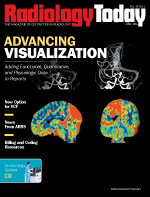 June 2014
June 2014
Where to Look for Answers
By Donna L. Christian, CIRCC, CEMC, COSC, CCS-P
Radiology Today
Vol. 15 No. 6 P. 25
Coders regularly are challenged with various quarterly and annual changes. Valuable time and revenue are at risk when researching and keeping up with ICD-10-CM, CPT, and HCPCS Level II annual updates; Centers for Medicare & Medicaid Services (CMS) regulations; National Correct Coding Initiative (NCCI) edits; changes for local and national coverage determinations; and commercial and private-payer changes.
This article looks at some resources that radiology coders may find useful in their search for answers to coding-related questions.
Training
Organizations such as AAPC and AHIMA offer radiology continuing education through webinars and live events along with ICD-10 training for coders and providers. AAPC also has more specialty-specific training, including resources for the radiology field such as the certified interventional radiology cardiovascular coder credential.
The interventional radiology discussion forum on AAPC’s website also provides a networking opportunity, and many questions already have been answered by expert coders in this forum. Additionally, the monthly magazine Healthcare Business Monthly has informative articles for general and radiology-specific coding.
Tools
Tools such as EncoderPro are efficient ways to find information for CPT code descriptions with guidelines, the most current NCCI edits, relative value units, CMS articles, etc. The amount of information coders can access is based on the level of their subscription. More advanced packages include more resources such as reference materials, CPT Assistant, and CMS fee schedules. Free trials also are available.
AAPC Coder contains a PDF download option for saving and sending attachments or articles to providers, the authorization/referral team, or the administrative team. Newsletter subscriptions and coding “survival guides” offer relevant radiology coding information, along with 20 CEUs annually.
The CPT tools from the American Medical Association (AMA) are helpful when used correctly. Coders should read the instruction notes at the beginning of every section, and changes will be identified in green with an arrow at the beginning and ending of the new or revised text. Coders also should review Appendix B in the CPT book every year for the summary of additions, deletions, and revisions that pertain to each specialty.
I’ve often found the CPT Assistant tool to be useful. A radiologist at my organization recently performed a soft tissue ultrasound of a patient’s upper back, and I wasn’t sure what CPT code to use. I found the answer in the May 2009 CPT Assistant using my software coding tool.
Websites
Coders should check the CMS website for the most current billing requirements using their search tool. The CMS runs the Medicare Learning Network, which publishes national articles that inform health care professionals about the latest changes to CMS programs. One article I recently used had specified payable ICD-9-CM codes, frequency standards, conditions for coverage, and advanced beneficiary notice guidance with a suggested statement for the patient. I’ve found that sometimes accessing these articles actually was easier through my code search tool than directly on the CMS website.
The ACR allows users to search for radiology coding questions and get answers. I recently used the search option on this site to find a chart for coding arthrography procedures. The Society of Interventional Radiology website also is a good place to read articles specific to this field or look for answers to interventional radiology questions.
Panacea (formerly MedLearn) has radiology and interventional reference books, anatomy charts, webcasts, and live seminars. Coders also can sign up for the Radiology Compliance Question of the Week, which answers relevant industry questions. Bracco Imaging includes an “Ask Bracco” e-mail option for radiology coding questions. Answers and references always come back quickly to those inquiries. And ZHealth Publishing offers radiology coding reference books, anatomy charts, webinars, and live seminars. They provide webinars for both AAPC and AHIMA.
There are several websites that have the ICD-9-CM to ICD-10-CM crosswalks by specialty (eg, AAPC, Panacea, AMA). These crosswalks will be helpful to speed up the process of selecting the most specific and accurate ICD-10-CM code when ICD-10 is implemented.
Final Thoughts
Coders should remember that coding impacts reimbursement staff, clinicians, referring physicians, administrative functions, and payers—virtually everyone in the organization. These resources and tools may not only be beneficial to coders but also to their entire organization.
— Donna L. Christian, CIRCC, CEMC, COSC, CCS-P, works for the Providence St Mary Medical Group in Walla Walla, Washington, and has more than 20 years of coding experience for multispecialty clinics.

